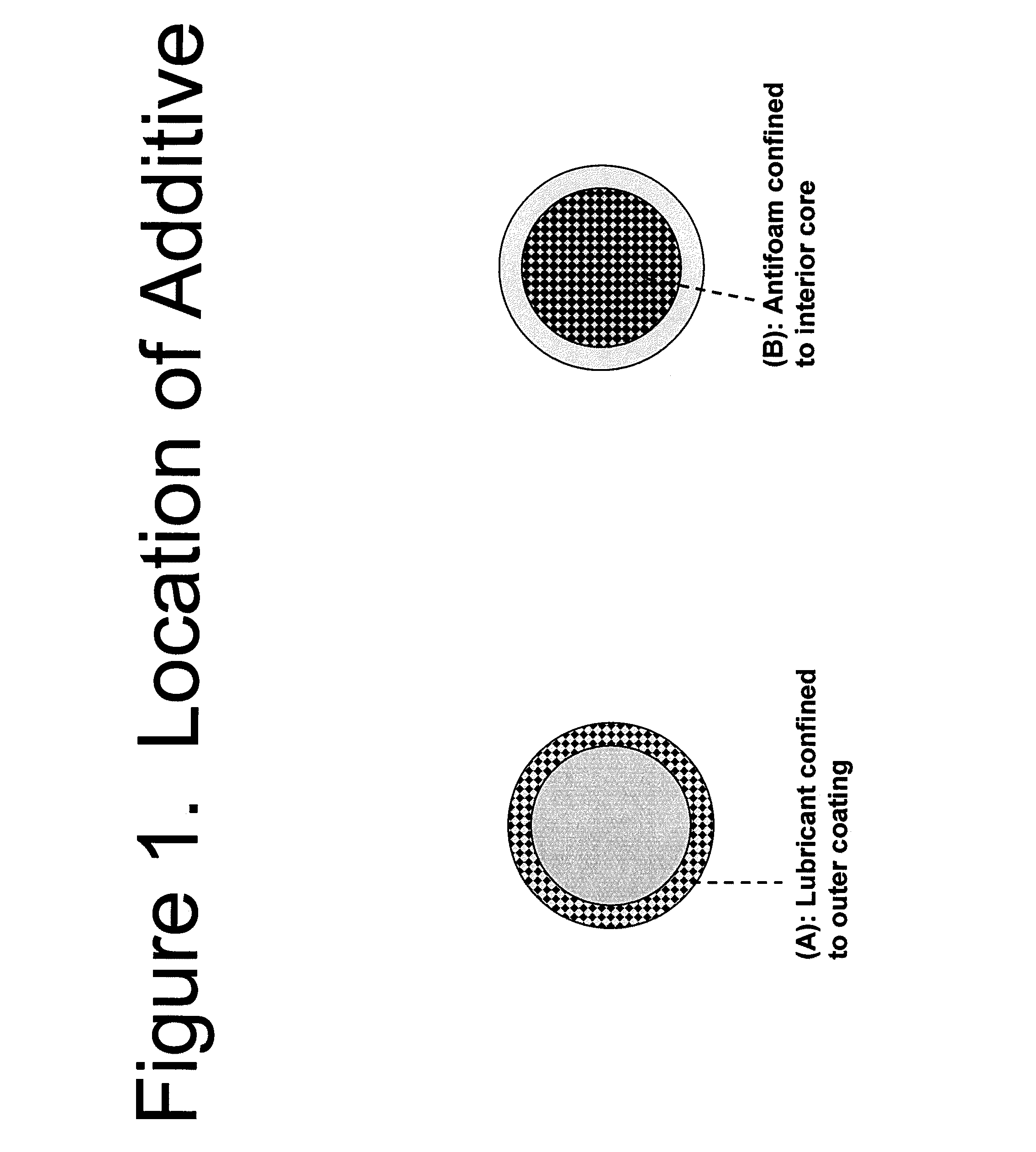Method for producing granules with reduced dust potential comprising an antifoam agent
a technology of antifoam and granules, which is applied in the direction of detergent compounding agents, inorganic carriers, instruments, etc., can solve the problems of severe allergic reactions, workers are often exposed to the contents of granules, etc., and achieve the effect of reducing the dusting potential of the produced granules
- Summary
- Abstract
- Description
- Claims
- Application Information
AI Technical Summary
Benefits of technology
Problems solved by technology
Method used
Image
Examples
example 1
[0047]In this example, a granule comprising a seed and three layers was produced wherein antifoaming agent was added to the enzyme layer. A control was prepared with no antifoam added and the dust levels were compared. To produce the granules, 1.0 kg of sucrose crystals was sieved to between 35 and 50 mesh were charged into Glatt 3 fluid bed coater and fluidizer. 1.6 Kg of an aqueous protease solution with 15.5% total dry solids was added to 3.27 kg of an aqueous solution containing 0.84 kg of sucrose and 0.84 kg of cornstarch. Lot #2 differed from lot #1 by the addition of 47 grams of the antifoaming agent ethylene oxide propylene oxide co-polymer (Mazu™ DF204) to the above described formulation. The protease solution was sprayed onto the sucrose seed crystal under the following conditions:
[0048]
Fluid feed rate 43 gram / minAtomization pressure 20 PSIProduct temp. 45° C.Inlet air flow100 CFM
[0049]The coated particles were then coated with an aqueous solution containing 1.6 kg (50% w / ...
example 2
[0055]In this experiment, antifoaming agent was added to the first layer (comprising enzyme) and the second layer (a coating layer comprising corn starch, titanium dioxide and neodol) and the dust potential was compared to a granule made without antifoam.
Lot 1 was prepared as follows:
[0056]25 kg sucrose crystals sieved to between 35 and 50 mesh were charged into Deseret 60 fluid bed coater and fluidizer. 39 Kg of an aqueous protease solution with 15.5% total dry solids was added to 63 kg of an aqueous solution containing 22.5 kg of sucrose and 22.5 kg of cornstarch.
Lot 2 was prepared as follows:
[0057]25 kg sucrose crystals sieved to between 35 and 50 mesh were charged into Deseret 60 fluid bed coater and fluidizer. 39 Kg of an aqueous protease solution with 15.5% total dry solids was added to 63 kg of an aqueous solution containing 21.3 kg of sucrose and 21.3 kg of cornstarch and 1.2 kg (1% w / w) of Mazu DF204.
[0058]Protease solutions were sprayed onto the sucrose crystals under the ...
example 3
[0066]In this example, antifoam was added to the third layer of a granule and compared to a granule prepared with no antifoaming agents.
[0067]25 kg sucrose crystals were sieved to between 35 and 50 mesh were charged into Deseret 60 fluid bed coater and fluidizer. 54 Kg of an aqueous protease solution with 21.4% total dry solids was added to 73 kg of an aqueous solution containing 20.6 kg of sucrose and 20.6 kg of cornstarch.
[0068]Protease solutions were sprayed onto the sucrose under the following conditions:
[0069]
Fluid feed rate 750 gram / minAtomization pressure 75 PSIProduct temp. 45° C.Inlet airflow1200 CFM
[0070]The coated particles were then coated with an aqueous solution containing 82.4 kg (40% w / w) of 11.7 kg (10.2% w / w) of sucrose, 11.7 kg of cornstarch, 6.9 kg (6.0% w / w) titanium dioxide and 1.5 kg (1.3% w / w) of neodol. This coating was applied under the following conditions:
[0071]
Fluid feed rate1200 gram / minAtomization pressure 60 PSIProduct temp. 45° C.Inlet air flow1200 C...
PUM
| Property | Measurement | Unit |
|---|---|---|
| length | aaaaa | aaaaa |
| melting point | aaaaa | aaaaa |
| melting point | aaaaa | aaaaa |
Abstract
Description
Claims
Application Information
 Login to View More
Login to View More - R&D
- Intellectual Property
- Life Sciences
- Materials
- Tech Scout
- Unparalleled Data Quality
- Higher Quality Content
- 60% Fewer Hallucinations
Browse by: Latest US Patents, China's latest patents, Technical Efficacy Thesaurus, Application Domain, Technology Topic, Popular Technical Reports.
© 2025 PatSnap. All rights reserved.Legal|Privacy policy|Modern Slavery Act Transparency Statement|Sitemap|About US| Contact US: help@patsnap.com

